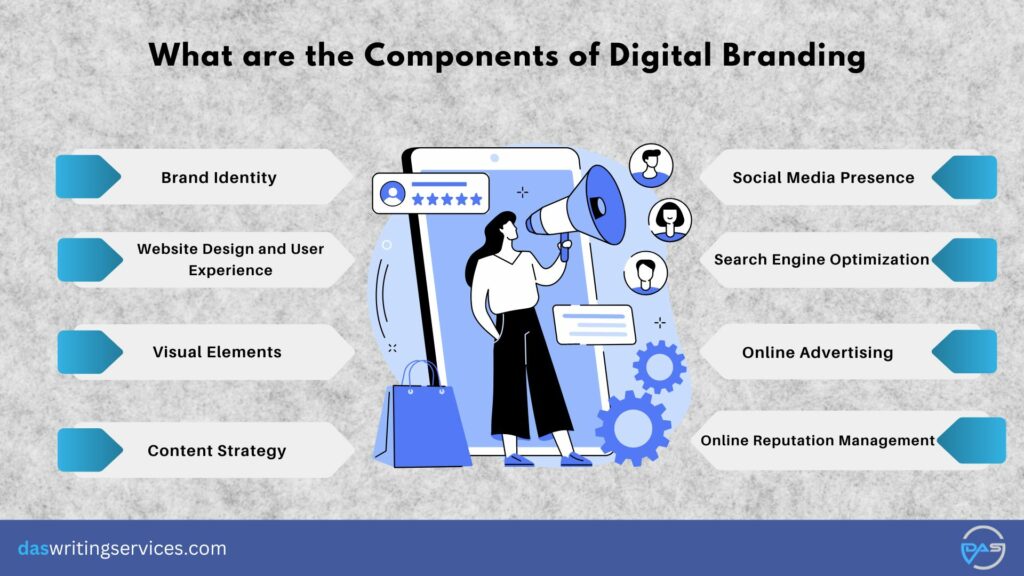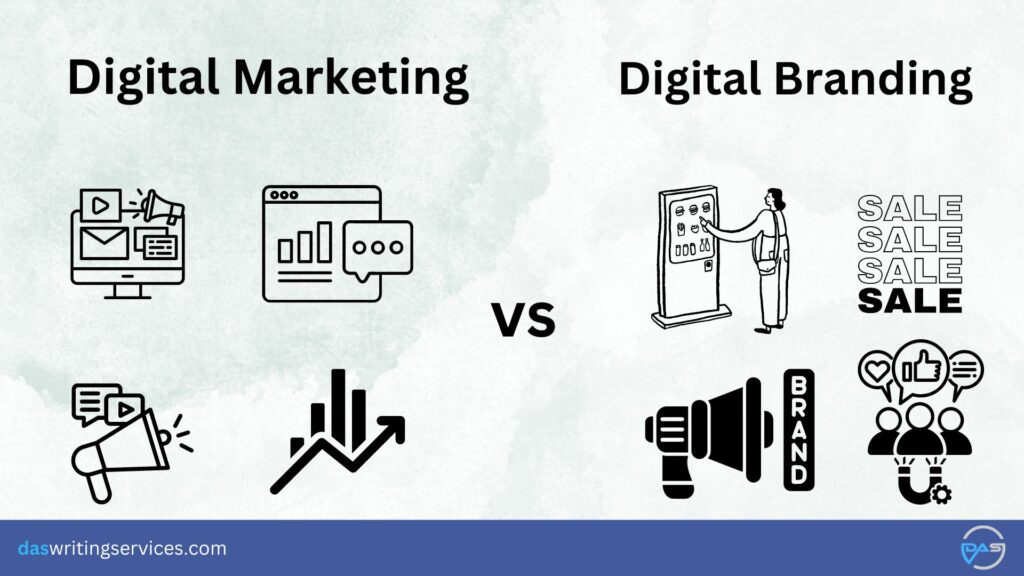Digital Branding is a part of marketing strategy where companies try to mark their presence online. While branding is the process of strategically and creatively telling your customers what your company is about, what is its motto and what the company cares for. Additionally, it also informs the audience what they can expect from you and why should they take service from you rather than others.
Previously this process was done offline but with the rapid increase in digitalisation, this process too has become online. A lot of companies are increasing their marketing budget for this. According to recent studies, more than 90% of companies, regardless of niche, size, and age, invest in the growth of the company’s acknowledgement and improvement of its position in the market.
Between 2020 and 2021, there was a 14% growth rate in digital marketing budget spending across businesses.
Digital branding is of utmost importance especially when doing content marketing for startups as this will make your product known.
In this blog, we have talked about the importance of digital branding and how you can create a successful strategy. Go through it part by part to know all about digital branding and how should you proceed further. You can also know what questions you can ask a content writing agency if taking services from them.
How to Create a Successful Digital Branding Strategy?
A successful digital brand possesses certain essential elements that contribute to its effectiveness and impact. Here are nine essentials of a successful digital brand:
1. Clear Brand Identity
A successful digital brand has a well-defined brand identity that encompasses its mission, values, personality, and unique selling proposition. This clarity helps the brand differentiate itself and resonate with its target audience.
2. Consistent Brand Messaging
Consistency in brand messaging across digital channels is crucial. A successful digital brand maintains a consistent tone of voice, key messages, and visual identity, ensuring that its brand is recognisable and memorable.
3. Engaging User Experience
A successful digital brand priorities user experience. It focuses on creating intuitive, user-friendly websites, apps, and interfaces that provide a seamless and enjoyable experience for visitors and customers.
4. Strong Visual Identity
A successful digital brand has a visually appealing and distinctive identity. It includes elements such as a well-designed logo, a consistent colour palette, and visually consistent branding across digital platforms to create a cohesive and recognisable brand image.
5. Content Excellence
A valuable and engaging content plan is a cornerstone of a well crafted branding. A successful digital brand consistently produces high-quality content, such as blog articles, videos, social media posts, and infographics, that educates, entertains, or inspires its target audience.
6. Active Social Media Presence
A successful digital brand leverages social media effectively. It engages with its audience, responds to comments and messages, shares relevant content, and builds relationships through platforms that align with its target audience and business objectives.
7. Strategic Digital Advertising
A successful digital brand utilises digital advertising strategically. It understands its target audience, uses data-driven insights to create targeted ad campaigns, and optimises advertising efforts to maximise reach, engagement, and conversions.
8. Data-driven Decision Making
A successful digital brand uses data and analytics to drive decision-making. It collects and analyses data related to website traffic, social media engagement, user behaviour, and customer feedback to refine its strategies, personalise experiences, and optimise its digital branding efforts.
9. Continuous Brand Monitoring and Adaptation
A successful digital brand understands the importance of monitoring its brand’s online reputation, social media conversations, and market trends. It adapts its strategies based on real-time feedback, consumer preferences, and emerging technologies to remain relevant and stay ahead of the competition.
By incorporating these nine essentials into their digital branding strategies, brands can enhance their online presence. Moreover, engage with their target audience, and build a successful digital brand that resonates with consumers and drives business growth.
What are the Components of Digital Branding?
Digital branding consists of several key components that work together to establish a strong online presence and shape the brand’s image. Here are some essential components of digital branding:

1. Brand Identity
This includes the brand’s core values, mission, vision, personality, and unique selling proposition (USP). Brand identity sets the foundation for all branding efforts, both offline and online.
2. Website Design and User Experience (UX)
A well-designed website is crucial for digital branding. It should be visually appealing, user-friendly, mobile-responsive, and optimised for search engines. The website should effectively communicate the brand’s message and provide a seamless user experience.
3. Visual Elements
Visual components such as logos, typography, colour schemes, and imagery play a significant role in digital branding. Consistent and visually appealing visual elements help create brand recognition and reinforce the brand’s identity across different digital platforms.
4. Content Strategy
Developing a comprehensive digital content strategy is vital for digital branding. It involves creating valuable, relevant, and engaging content that aligns with the brand’s identity and resonates with the target audience. Content can include blog articles, videos, social media posts, infographics, podcasts, and more.
5. Social Media Presence
Establishing and maintaining an active presence on relevant social media platforms is crucial for digital branding. It involves creating engaging content, interacting with the audience, responding to comments and messages. Additionally, leveraging social media advertising and influencer partnerships. In this competitive market, ensure that your company has a presence on top social media platforms like Instagram, Facebook and LinkedIn
6. Search Engine Optimisation (SEO)
Optimising digital content and the brand’s website for search engines is essential to improve online visibility. This involves keyword research, on-page optimisation, backlink building, and technical SEO practices to enhance the brand’s organic search rankings. You can use tools like Ahrefs, and Google Keyword Planner for keyword research.
7. Online Advertising
Digital branding often includes strategic online advertising campaigns. This can involve paid search ads, display ads, social media ads, influencer collaborations, and other forms of digital advertising to reach the target audience and promote the brand effectively.
8. Online Reputation Management
Maintaining a positive brand image and managing an online reputation is crucial in the digital realm. This includes monitoring and responding to customer reviews, addressing customer concerns or complaints, and actively engaging with the audience on various digital channels.
9. Data Analytics and Measurement
Utilising digital analytics tools and tracking metrics is essential for evaluating the effectiveness of digital branding efforts. Measuring website traffic, engagement metrics, conversion rates, social media analytics, and other relevant data helps identify trends, make data-driven decisions, and optimise digital branding strategies.
These components work together to create a cohesive and impactful digital branding strategy. This can help any business establish its presence, engage with the target audience as well as shape its reputation in the digital space.
What is the Importance of Digital Branding?
In today’s digital age, where online presence dominates the business world, digital branding has emerged as a crucial element for organisations aiming to establish a strong foothold and thrive in their respective industries. Digital branding encompasses the strategies and techniques employed to shape and promote a company’s online identity, allowing it to engage with its target audience effectively. This article explores the importance of digital branding and its various benefits for businesses in the contemporary landscape.
1. Building Brand Identity and Recognition
Digital branding plays a pivotal role in establishing a distinctive brand identity and increasing recognition. A well-crafted brand marketing strategy allows companies to define their core values, mission, and vision, ensuring consistency across all digital channels. By employing consistent brand messaging, visuals, and tone of voice, businesses can create a memorable brand image that resonates with their target audience, fostering trust and loyalty.
2. Expanding Reach and Visibility
Digital branding opens up vast opportunities for businesses to expand their reach and increase visibility. With the growing number of internet users worldwide, having a strong digital presence enables companies to connect with a global audience, irrespective of geographical boundaries. Through digital channels such as websites, social media platforms, and online advertising, businesses can effectively reach and engage with their target market, thus amplifying their brand’s visibility and exposure.
3. Enhancing Customer Engagement and Relationships
Digital branding facilitates meaningful customer engagement and fosters strong relationships with the target audience. By leveraging social media platforms, email marketing, and interactive content, companies can actively communicate and interact with their customers. This provides them with valuable information, personalised experiences, and prompt customer support. This level of engagement not only strengthens brand loyalty but also allows businesses to gain insights into customer preferences and behaviours, enabling them to tailor their offerings accordingly.
4. Establishing Credibility and Trust
A well-executed digital branding strategy helps establish credibility and foster trust among consumers. In the online landscape, where competition is fierce, consumers seek reassurance and validation before making purchasing decisions. By showcasing expertise, thought leadership, and positive customer experiences through digital channels, businesses can build credibility and instil confidence in their target audience. Consistent branding across all touchpoints also helps in establishing trust and reliability, further enhancing the brand’s reputation.
5. Driving Business Growth and Success
Effective digital branding directly contributes to business growth and success. A strong brand presence in the digital realm can significantly impact sales and revenue generation. By creating brand advocates through positive customer experiences and engagement, businesses can increase customer retention rates and drive customer acquisition. Moreover, a well-defined digital brand strategy helps differentiate a company from its competitors, giving it a competitive edge and positioning it as a preferred choice among consumers.
What is the Difference Between Digital Marketing vs Digital Branding?
Digital Marketing and Digital Branding are two distinct concepts, although they are closely related and often work together to achieve common goals. Here’s a breakdown of the differences between the two:

Scope and Focus
Digital Marketing: Digital marketing refers to the overall strategies and tactics employed to promote products or services using digital channels. It encompasses various activities such as search engine optimisation (SEO), social media marketing, email marketing, content marketing, pay-per-click (PPC) advertising, and more. The primary focus of digital marketing is to drive traffic, generate leads, and ultimately convert them into customers.
Digital Branding: Digital branding, on the other hand, is a subset of digital marketing that specifically focuses on building and managing a brand’s online presence. It involves shaping and communicating a brand’s identity, values, and personality through digital channels. Digital branding strategies aim to establish a strong and consistent brand image, enhance brand recognition, foster trust and loyalty, and differentiate the brand from competitors.
Objectives
Digital Marketing: The primary objective is to drive measurable results, such as increasing website traffic, generating leads, boosting sales, and achieving a positive return on investment (ROI). It focuses on achieving specific marketing goals and targets through various digital tactics.
Digital Branding: Here, the primary objective is to create a strong brand presence and reputation in the online realm. It aims to build brand awareness, establish credibility and trust, foster customer loyalty, and differentiate the brand from competitors. Digital branding focuses on long-term brand building and shaping the overall perception of the brand among the target audience.
Timeframe and Approach
Digital Marketing: Digital marketing campaigns are often time-bound and centred around specific marketing goals. They are designed to generate immediate results and drive short-term conversions. Digital marketing tactics are highly targeted, data-driven, and optimised for specific outcomes, such as increasing sales within a particular timeframe.
Digital Branding: It takes a more long-term approach and is focused on building a strong brand identity and reputation over time. It involves consistent messaging, visual identity, and tone of voice across all digital touchpoints. Digital branding strategies aim to create a lasting impression on the target audience and establish a deep emotional connection with them.
Audience Engagement
Digital Marketing: Digital marketing strategies primarily focus on driving customer actions, such as making a purchase, subscribing to a newsletter, or filling out a form. It involves targeted messaging, persuasive calls-to-action, and optimising conversion funnels to maximise customer engagement and drive conversions.
Digital Branding: It aims to engage the audience on a deeper level by establishing an emotional connection and building brand loyalty. It involves storytelling, content creation, interactive experiences, and social media engagement to create a meaningful relationship with customers. The goal is to create brand advocates who not only make purchases but also actively promote and recommend the brand to others.
In essence, digital marketing and digital branding are complementary aspects of a comprehensive digital strategy. While digital marketing focuses on driving immediate results and conversions, digital branding is centred around building a strong brand identity, reputation, and long-term customer loyalty. Together, they form a cohesive approach to effectively promote a brand in the digital landscape.
Final Takeaway
In the digital era, where online interactions and engagements have become integral to our lives, digital branding has emerged as a vital aspect of business success. It enables companies to create a compelling brand identity, expand their reach, enhance customer engagement, establish credibility, and drive business growth. By investing in a robust strategy, businesses can navigate the digital landscape effectively. This helps in connecting with their target audience on a deeper level and gaining a competitive advantage in the market.
If you are confused about what type of content aligns with your business, read our post on blog ideas for your business. And if you need help with your content demands, get in touch with our expert content team and ask for a free sample.





Leave a comment
All comments
drover sointeru
My spouse and i felt now lucky that Ervin could finish up his web research by way of the ideas he gained in your blog. It's not at all simplistic to simply choose to be releasing points which many others could have been trying to sell. And now we consider we have got the blog owner to be grateful to for that. The main illustrations you made, the straightforward web site navigation, the friendships you can assist to create - it's got many excellent, and it is facilitating our son in addition to our family understand the concept is exciting, which is truly pressing. Many thanks for all!